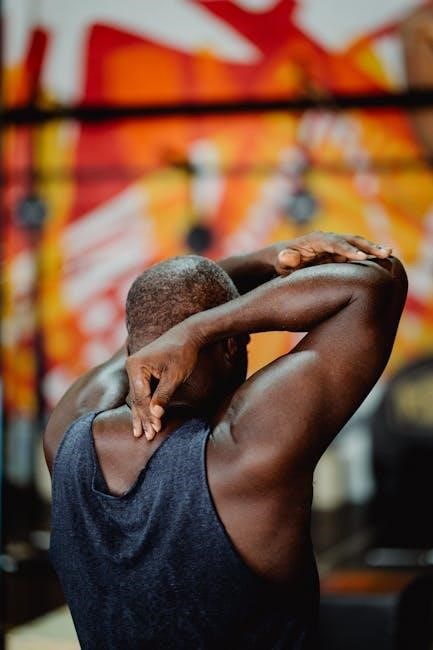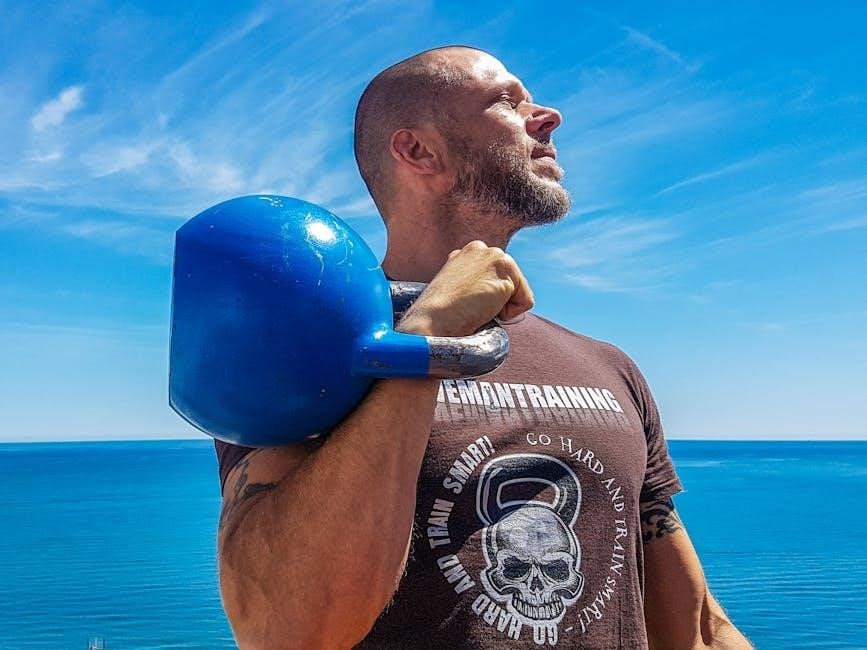Shoulder stabilisation exercises are essential for enhancing joint stability‚ preventing injuries‚ and improving overall shoulder function. These exercises strengthen muscles‚ promote proper alignment‚ and support long-term joint health.
Why Shoulder Stability Matters
Shoulder stability is crucial for preventing injuries‚ enhancing mobility‚ and supporting the surrounding muscles. Proper stability ensures the shoulder joint operates efficiently‚ reducing the risk of dislocations and chronic pain. Strong stabilisation promotes better posture‚ improves athletic performance‚ and maintains overall shoulder health. Poor stability can lead to impingement‚ strained muscles‚ and limited functionality. Addressing shoulder stability through targeted exercises helps restore balance‚ strength‚ and resilience‚ ensuring optimal joint mechanics and longevity.
Common Causes of Shoulder Instability
Shoulder instability often arises from trauma‚ repetitive strain‚ or muscle imbalances. Traumatic injuries‚ such as falls or sports accidents‚ can dislocate the shoulder‚ weakening joint structures. Repetitive overhead movements‚ common in athletics or labor‚ can strain ligaments and muscles‚ leading to chronic instability. Additionally‚ natural ligament laxity or poor scapular stabilization can predispose individuals to instability. Addressing these causes through targeted exercises and proper rehabilitation is essential to restore joint stability and prevent further complications.

Understanding Shoulder Anatomy for Stabilisation
The shoulder joint‚ a complex ball-and-socket joint‚ relies on the rotator cuff‚ scapula‚ and ligaments for stability. Proper alignment and muscle coordination are crucial for optimal function.
The Role of the Rotator Cuff
The rotator cuff‚ comprising four muscles (supraspinatus‚ infraspinatus‚ teres minor‚ and subscapularis)‚ plays a crucial role in shoulder stabilisation. It provides dynamic stability by controlling joint movements and preventing dislocation. Strengthening these muscles through exercises like external rotations and scapular squeezes enhances joint integrity and reduces injury risk. A weak rotator cuff can lead to instability‚ pain‚ and limited mobility‚ making it essential for rehabilitation and preventive care to focus on these muscles.
Scapular Stabilisation and Its Importance
Scapular stabilisation is vital for maintaining proper shoulder mechanics and preventing injuries. The scapula acts as the base for shoulder movements‚ and its stability is achieved through muscles like the trapezius‚ rhomboids‚ and levator scapulae. Weakness or poor control of these muscles can lead to shoulder impingement‚ poor posture‚ and reduced athletic performance. Exercises such as shoulder blade squeezes and wall slides target these muscles‚ enhancing scapular mobility and strength. Proper scapular stabilisation improves joint alignment‚ reduces injury risk‚ and supports overall shoulder health and functionality in both daily activities and sports.

Phase I: Foundational Shoulder Stabilisation Exercises
Phase I focuses on building basic strength and stability through exercises like shoulder blade squeezes and wall slides‚ targeting scapular control and proper movement patterns.
Shoulder Blade Squeezes (Scapular Retraction)
Shoulder blade squeezes‚ or scapular retractions‚ are foundational exercises that strengthen the muscles between the shoulder blades. To perform‚ sit or stand with good posture‚ squeeze your shoulder blades together‚ and hold for 5 seconds. Avoid shrugging your shoulders. This exercise improves scapular stability‚ enhances posture‚ and reduces shoulder tension. It’s a simple yet effective movement for building awareness and strength in the upper back‚ crucial for overall shoulder stability and injury prevention. Regular practice helps maintain proper shoulder mechanics and supports long-term joint health.
Wall Slides for Scapular Mobility
Wall slides are excellent for improving scapular mobility and posture. Stand with your back against a wall‚ arms extended overhead‚ and elbows at 90 degrees. Slowly slide your arms upward‚ keeping your shoulders relaxed‚ then return to the starting position. This exercise enhances thoracic spine mobility‚ reduces shoulder tightness‚ and promotes proper scapular movement. Regular practice helps maintain flexibility and prevents shoulder impingement. It’s a gentle‚ effective movement for improving overall shoulder function and stability‚ making it ideal for both rehabilitation and maintenance routines.
Phase II: Intermediate Exercises for Shoulder Stability
Phase II introduces resistance band external rotations and bird dog exercises to enhance strength and control‚ building on foundational stability while improving dynamic movement and functional strength.
Resistance Band External Rotation
Resistance band external rotation targets the rotator cuff muscles‚ particularly the infraspinatus‚ to enhance strength and stability. Anchor the band at shoulder height and hold it with both hands. Keeping elbows close to your sides‚ rotate the band outward‚ squeezing your shoulder blades. Maintain proper form by keeping shoulders relaxed and down. Perform 3 sets of 12-15 repetitions. Focus on controlled movements to avoid jerky actions. This exercise improves rotational strength and stability‚ benefiting activities like throwing or swimming. Progress resistance as strength improves‚ ensuring consistent form throughout the exercise.
Bird Dog Exercise for Core and Shoulder Stability
The Bird Dog exercise strengthens the core and enhances shoulder stability by engaging the rotator cuff and scapular stabilizers. Start on hands and knees in a quadruped position. Extend one arm forward and the opposite leg backward‚ maintaining a neutral spine. Hold for 3-5 seconds‚ then return to the starting position. Perform 3 sets of 8-10 repetitions on each side. This exercise improves balance‚ posture‚ and overall stability while reducing the risk of shoulder injuries. Progress by increasing hold duration or adding resistance as strength improves.
Phase III: Advanced Shoulder Stabilisation Exercises
Phase III focuses on dynamic stabilisation and functional movements‚ progressing from foundational exercises to enhance strength‚ control‚ and real-world application of shoulder stability.
Dynamic Stabilisation with Resistance Bands
Dynamic stabilisation with resistance bands is an advanced exercise that challenges the shoulder muscles to maintain control during movement. Using a resistance band‚ perform controlled arm movements while keeping the shoulders stable. This exercise targets the rotator cuff and scapular stabilisers‚ improving muscle endurance and functional strength. It mimics real-world movements‚ enhancing joint stability in various positions. Resistance bands are versatile‚ allowing progression by increasing tension. Regular practice helps prevent injuries and improves overall shoulder function‚ making it a valuable addition to any shoulder rehabilitation or strengthening program.
Functional Activities for Real-World Stability
Functional activities mimic daily tasks or sports movements to enhance shoulder stability in practical scenarios. Examples include carrying groceries‚ reaching overhead‚ or performing weight transfer exercises. These activities strengthen the shoulder muscles while improving coordination and balance. Progression involves increasing difficulty‚ such as adding weight or complexity to movements. Regular practice enhances joint stability‚ reducing the risk of injury during everyday activities or athletic performance. Focus on controlled movements to maximize benefits and ensure proper form.

Implementing a Shoulder Stabilisation Exercise Routine
A structured approach is key to EFFECTIVE shoulder stabilisation; Begin with foundational exercises‚ progress gradually‚ and incorporate activities that mimic daily movements. Professional guidance ensures safety and optimal results.

Frequency and Progression of Exercises
Exercises should be performed 3-4 times weekly‚ starting with Phase I foundational movements like shoulder blade squeezes and wall slides. Progress to intermediate and advanced phases as strength and control improve. Each phase builds on the previous‚ ensuring gradual overload and adaptation. Focus on proper form and avoid rushing through progression. Professional guidance is crucial to tailor routines to individual needs and prevent overtraining or injury. Consistency and patience are key to achieving long-term shoulder stability and functionality.
Common Mistakes to Avoid During Exercises
Common mistakes include rushing through exercises without proper form‚ using excessive weight‚ and neglecting to engage the core. Overlooking scapular control can lead to poor mechanics and potential injury. Avoid shrugging shoulders or using momentum to lift weights. Ensure proper posture and maintain a slow‚ controlled tempo during movements. Ignoring breathing techniques can also compromise effectiveness. Focus on precise execution and gradually increase intensity to maximize benefits and prevent setbacks in your shoulder stabilisation journey.
Consistency is key to achieving lasting shoulder stability. Regular practice strengthens muscles‚ enhances joint health‚ and reduces injury risk‚ ensuring long-term benefits for overall shoulder function.
Long-Term Benefits of Shoulder Stabilisation
Regular shoulder stabilisation exercises offer numerous long-term benefits‚ including improved joint stability‚ reduced injury risk‚ and enhanced overall shoulder function. Strengthening the rotator cuff and scapular muscles leads to better posture‚ reduced chronic pain‚ and increased athletic performance. Consistent practice also promotes proper joint alignment‚ preventing wear and tear‚ and supports long-term joint health. Over time‚ these exercises foster confidence in daily activities and sports‚ ensuring shoulders remain strong and resilient for years to come.
Motivation and Maintenance Tips
Consistency is key to maintaining shoulder health. Track progress‚ celebrate small milestones‚ and set realistic goals. Incorporate exercises into your daily routine‚ even for a few minutes‚ to build a sustainable habit. Use reminders or schedule workouts in your calendar. Engage in activities you enjoy to stay motivated. Include core and full-body exercises to enhance overall stability. Seek professional guidance to tailor exercises to your needs; Regular practice ensures long-term benefits and prevents setbacks‚ keeping your shoulders strong and resilient for years to come.
